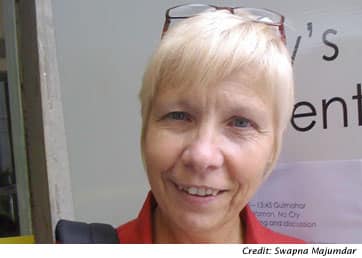
.jpg) NEW DELHI (WOMENSENEWS)–With only five years to go until the 2015 deadline to achieve the U.N.’s Millennium Development Goals, which seek to eradicate global poverty, Wendy Graham says fear of failure should not hold anyone back from trying harder.
NEW DELHI (WOMENSENEWS)–With only five years to go until the 2015 deadline to achieve the U.N.’s Millennium Development Goals, which seek to eradicate global poverty, Wendy Graham says fear of failure should not hold anyone back from trying harder.
"Ever tried? Ever failed? No matter. Try again. Fail again. Fail again better," Graham, a professor of obstetric epidemiology at the University of Aberdeen in Scotland, urged 600 health experts from 55 countries.
The experts recently gathered here to focus on MDG No. 5, which seeks a 75 percent reduction in maternal mortality by 2015. The meeting, which took place Aug. 30-Sept. 1, was held as a warm up for the major U.N. meeting that starts tomorrow in New York to monitor progress toward global promises made by 189 member nations of the United Nations General Assembly in 2000 to improve worldwide living conditions.
"We have to understand that the F (failure) word is not so bad," Graham told the maternal health conference, which was organized by the Maternal Health Task Force at EngenderHealth, an international reproductive health organization based in New York City, and the New Delhi-based Public Health Foundation of India. "Health activists need to become ‘connoisseurs of failure’ if they are to learn from interventions that failed…If an initiative succeeds in one place, there is no guarantee that it will succeed in the next. We must consider the unique context of each setting where we work."
Graham, a proponent of crystallizing public health disparities in quantitative terms, often points to the gap between women’s risk of dying from pregnancy-related causes in poorer counters (1:4) and in the richest nations (1:10,000).
She contends this 2500-fold difference is the largest gap between the developing and developed world of all public health statistics. "The frequency of these tragic deaths in the 21st century is a global collective failure," she told Women’s eNews.
India’s High Maternal Deaths
India, with the highest number of maternal deaths in the world, offers what Graham sees as a valuable lesson plan in failures. In India, 1-in-48 women is at risk of dying during childbirth.
Since India is so large and varied–in its geography, culture and politics–the efforts and outcomes of health projects can be relevant for many other parts of the world. "When India learns, it learns for many other countries," said Graham.
One instructive recent failure in India involves a project launched in April 2005 by the National Rural Health Mission to lower maternal and neonatal mortality by offering cash payments to women who keep prenatal checkup appointments and seek skilled delivery care. Although the number of women availing this incentive scheme has grown, many, especially those living in remote areas and belonging to the lowest rung of the Indian caste hierarchy, continue to face discrimination and denial of quality health care.
Graham cautioned that while increasing coverage of health services was important, more of it would not necessarily help vulnerable and marginalized woman unless it was the right kind of care.
"The coverage is important because of the vastness of India. But it cannot achieve its goal of saving the lives of mothers and newborns if there is no quality of care. The Indian government has realized that quality of services now needs to be urgently addressed. So they have learnt from their failure," she said.
Another Glaring Failure
Another glaring global failure, Graham pointed to was the persistence of unclean birthing practices, which she said Dr. Alexander Gordon, a physician in Aberdeen, Scotland, identified in 1795 as one of the major reasons for maternal deaths. These deaths can be prevented if countries prioritize clean birthing practices, Graham said.
"Our focus should be the ‘six cleans’ that make up a clean birth: clean hands, clean perineum, clean delivery surface, clean cord cutting implement, clean cord tying, and clean cord care," she said.
Graham added that the risk of a woman dying during childbirth in the poorest parts of the world today was still greater than it was in the United Kingdom during the time of Gordon.
"What makes the statistics all the more shocking is the length of time the world has known how to prevent women and babies dying around the time of childbirth," she said.
Graham established Immpact, a global research program at Aberdeen University, to highlight the role of research-based evidence in pushing progress towards MDG No. 5.
Such research, for instance, has helped to demonstrate that if women go to clinics with trained staff or midwives and proper equipment, an estimated 50 percent of mothers and newborns could be saved. If quality post-birth care is routinely provided for women, up to two-thirds of lives may be saved.
"Numbers are required to target policymakers to ensure women get the quality of care they deserve, including clean birth and respectful care of her body," Graham said.
Would you like to Comment but not sure how? Visit our help page at https://womensenews.org/help-making-comments-womens-enews-stories.
Swapna Majumdar is based in New Delhi, India, and writes about politics, development and gender.
For more information:
EngenderHealth:
http://www.engenderhealth.org
EngenderHealth’s Maternal Health Task Force:
http://www.maternalhealthtaskforce.org


